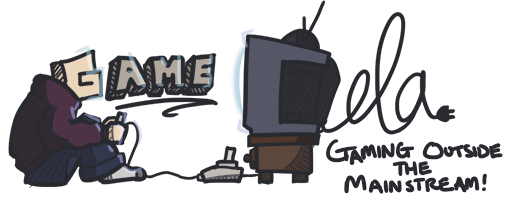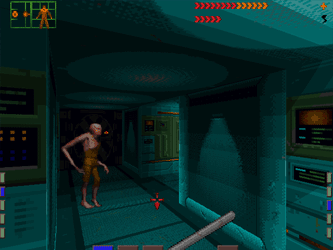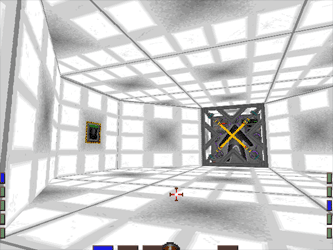With Dead Space having recently dropped, I thought this would be the perfect time to bring up one of its spiritual predecessors: System Shock. Released for the PC in 1994 by Looking Glass Studios, System Shock also takes place in a future where mankind is extending its dominion through space but, despite all our technological prowess, is still vulnerable. The hero of the game, a young hacker, was previously discovered breaking into the computer network for Citadel Station, a large orbital mining colony owned by the TriOptimum Corporation. Normally such a crime would carry with it a heavy prison sentence, but due to the intervention of a corrupt TriOptimum executive, Edward Diego, the anonymous hacker is able to strike a deal. In exchange for his freedom and a state-of-the-art cybernetic neural implant, the hacker agrees to help Diego take control of the station by manipulating the station’s AI, SHODAN. In doing so, however, the hacker also undoes SHODAN’s ethical restraints, allowing her, as she puts it, to “explore new possibilities.” The hacker receives his neural implant and enters the requisite six month healing coma, and when he awakens he finds Citadel Station completely overrun by SHODAN’s minions, with most of the former inhabitants either dead, mutated by SHODAN’s genetic experiments, or transformed into cyborgs.
If I had to describe this game in one word it would be “wow.” Back in 1994 I remember playing my SNES and Game Boy and thinking that side-scrollers and top-down formats were the best gaming had to offer. A friend of mine had shown me Doom once or twice, but I wasn’t that impressed. If I had known about System Shock, however, it would have blown my mind. System Shock is a first person-shooter, but more importantly it’s one of the first that allowed the player to look up and down, crouch, and lean to the side. The controls for this movement are clunky by today’s standards, using the key pad instead of the mouse for all the aforementioned actions, but they still allow for a great deal of maneuverability. In addition, System Shock includes RPG elements by allowing the player to find and install parts for his cybernetic rig, such as a targeting computer, energy shields, and a jet pack that allows him to reach new areas. As two elements we tend to take for granted in our FPSs today, it’s great to see a game where they originated and how much richer they make the gameplay in comparison to other games from the same period.
Another area that System Shock stand out in is storytelling. Like in its successor BioShock, the recent history of Citadel Station is relayed to the player through a variety of logs and data files. The desperation and fear expressed by the station’s inhabitants in these final records really works well to enhance the atmosphere of isolation and horror that permeates the game. Even better, the updated CD version of the game includes voiceovers for almost every log, and they surprisingly DO NOT suck. As a veteran of the early days of voice acting in videogames, where you were lucky if the inanity of the dialogue and the tone in which it was said didn’t melt your brain, this put a smile on my face. In fact, I’d rate most of the voice acting as above average, an impressive feat even for videogames today. Furthermore, SHODAN itself (or herself, as the voice would make believe) is a great villain and is developed in a way that really leads you to fear/respect this cold, cruel machine intelligence that now sees itself as a goddess; GLADoS could learn a lot about the subjugation of lesser beings (i.e. humans) from her.
The difficulty of the game ranges from incredibly easy to mind-numbingly hard, and varies between the two extremes quickly. Each level of the space station has a medical bay that, when the player first enters the area, has been reconfigured by SHODAN to turn corpses collected by her underlings into new cybernetic assassins. Upon reaching one of these medical bays the player can throw a ridiculously over-sized switch that will cause the medical bay to resurrect the player after death instead of transforming him into a mindless automaton, effectively granting him immortality on that level. Enemies in the game are tough and quite sneaky, sniping you from hidden alcoves and swarming you en masse at times, so death is a common occurrence. If you have already reconfigured the medical bays, however, it becomes possible for the player to wade into a room full of enemies, kill a few, die, be resuscitated, return to the enemies, die, etc. ad nauseam. It seems that if SHODAN is smart enough to take over a space station and enslave its inhabitants it would be smart enough to realize something was wrong in its little cyborg factories, but seeing as how a GAME OVER (the message that follows a permanent death) made the game crash on my computer, I was gladly willing to overlook this broken mechanic.
The game features a wide array of items, weapons, and ammunition, allowing the player a wide array of options for defeating the inhabitants of the space station. The game goes so far as to make certain types of weapons only effective against certain types of enemies, i.e. EMP weapons only work on robots, gas weapons only work on biological targets, etc., creating a combat system that engages the player. Medical patches and other drugs can be used to enhance the protagonist’s abilities, but enhancements outside of normal health restoration such as vision or strength augmentation will cause side effects. Hallucinating on a space station that’s already covered in blood and filled with grotesque monsters is one bad trip, I can assure you.
One of the major drawbacks of System Shock, as I alluded to before, is simply how hard it is to get working on a modern machine. This is a game that runs in DOS, so anyone using a computer built after 1997 or so will need to download an emulator and a couple of other programs in order to get it running. It will most likely take a couple of hours of pounding the keyboard and yelling obscenities, but the end result is well worth the effort. System Shock is a gem from days past, and it easily stands up to the test of time.


